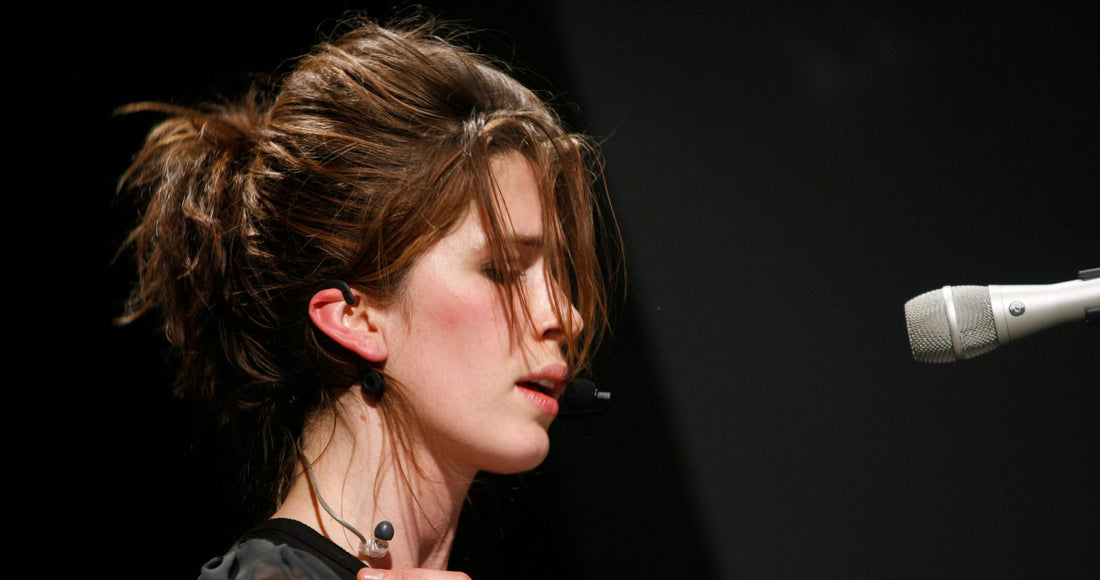In the 20 years since her first album appeared, British artist Imogen Heap has released only three more full-length solo records. But when you consider that she’s composing, arranging, singing, playing all of the instruments, producing, and even inventing new musical technology, you can understand why each project takes her so long. That, plus the fact that she’s a perfectionist.
Her 1998 debut, iMegaphone (the title is an anagram of her name, fair warning to potential listeners that she’s proudly a nerd), set a high bar for musical ingenuity and poetic courage. It takes some daring to introduce yourself to the world with a song like “Sweet Religion,” which questions the existence of eternal life after death. The opening piano riff, played by the musically well-educated Heap, sounds like a nod to the bizarre French composer Erik Satie (1866-1925). Intricate rhythms and rhymes in the lyrics match technique to content:
Am I on another level?
A learning vessel of several
Lessons to make me more clever
“Sweet Religion” represents the aggressive, furiously intellectual Heap, but she has another side – gentle, ephemeral, romantic. With the almost comatose “Sleep,” she succeeds in putting into musical terms a shared human physical experience, which is no easy task. You could call “Sleep” a deconstruction of the concept of lullaby. It’s also a masterpiece of synthesized orchestration; notice how the acoustic elements (piano, voice) are miked so close that they seem as artificially created as the rest of this sound world:
In the few years following iMegaphone, Heap sang in a band called Frou Frou. Their only album, Details (2002), has a more accessible pop sound with less brainy idiosyncrasies. In other words, it’s not nearly as interesting as Heap’s solo work.
Fortunately, another solo effort followed a few years later. Heap solidified her reputation as a songwriter and creative producer in the 2005 album Speak for Yourself. “Clear the Area” opens with a palette of atmospheric sounds that don’t prepare the ear for the way the music condenses in to a regular and rather funky beat. The windy rushes never go away, even more percussive samples take over the song’s motion. It’s this kind of unexpected combination of textures that makes Heap an arranger/producer worth watching.
Also from Speak for Yourself, “Hide and Seek” is fascinating a cappella work built from countless layers of Heap’s own voice. The song gained her many fans who’d never heard anything quite like it.
First there’s its mesmerizing sonic environment: using a device called a vocorder, Heap makes each vocal phrase sound like it’s being swallowed up. And then there’s its image-rich poetry. Lines like “The dust has only just begun to form crop circles in the carpet” and “Oily marks appear on the walls where pleasure moments hung before” have sparked debates online about the song’s meaning. Fans swear the lyrics depict everything from a romantic break-up, to the aftermath of Heap’s father’s death, to the Trail of Tears.
Speak for Yourself sold well for a self-produced album, especially in the U.K. The closest Heap has come to a hit on the charts in the U.S. (partly thanks to the support of David Letterman, who invited her to perform it on Late Night) is the catchy single “First Train Home” from Ellipse (2009). A meatier example from that album is “Swoon,” a high-energy exploration of the mysteries of new love; its irregular rhythms and odd harmonic meandering keep it from being an ordinary pop song.
Not everything on Ellipse is a reach for the charts. Heap broaches the taboo subject of body image in “Bad Body Double,” which she wrote during a period when she was out of shape (by her standards, anyway!) and was visualizing her more flaccid self as a separate entity who pushes her way awkwardly into real-life situations. This is a good example of Heap’s sense of humor, and it also includes some interesting samples, including rain that she recorded the yard of her home-cum-studio in Essex:
As she was brainstorming the experimental album Sparks (2014), Heap developed a remarkable invention to assist not only her composing via computer, but also her live performances with spontaneous digital accompaniment. In this video she explains and demonstrates her Mi.Mu Gloves:
Sparks is different from Heap’s other albums because it incorporates about 900 sound files (“sound seeds,” as she called them) donated by her fans over several years. Beginning in 2011, she released a sound seed song every three months until she had an album’s worth. “Me, the Machine,” debuted at an Earth Day celebration, used the Mi.Mu Gloves and shows Heap’s leaning toward a dreampop sound. (The 2-CD version of the album also includes instrumental versions of each song.)
Between creating albums and inventions, Heap has been involved in other types of projects. Many know her work from the teen T.V. show, The O.C. A more recent success was her score of incidental music for the play Harry Potter and the Cursed Child, a hit on the West End and Broadway, garnering Heap both a 2017 Olivier and a 2018 Drama Desk award.
But it’s been four years since her last album, so hopefully any day now….



